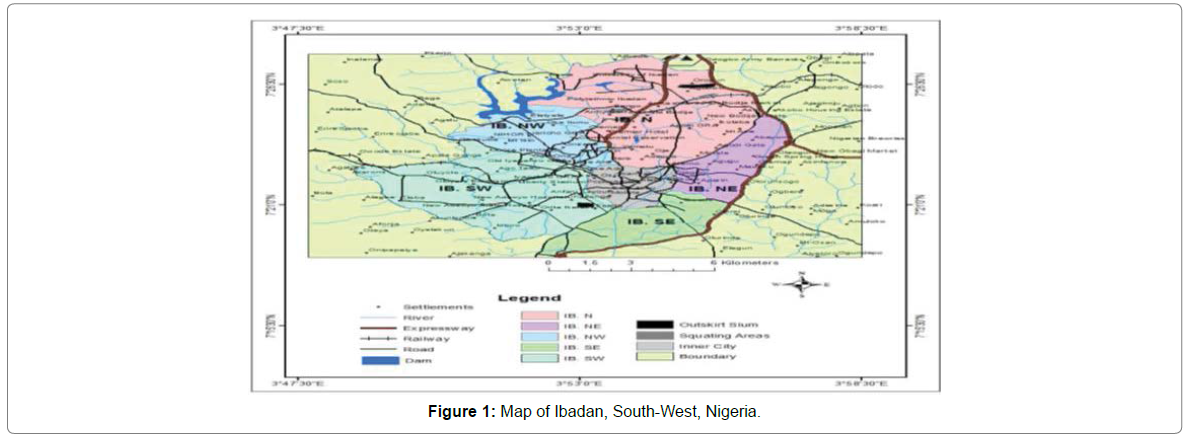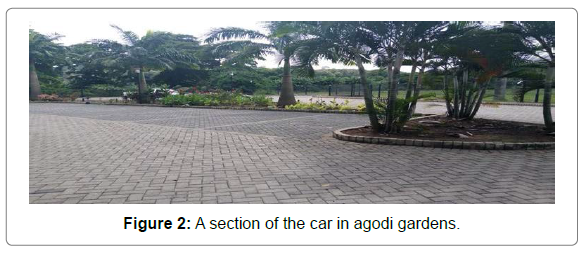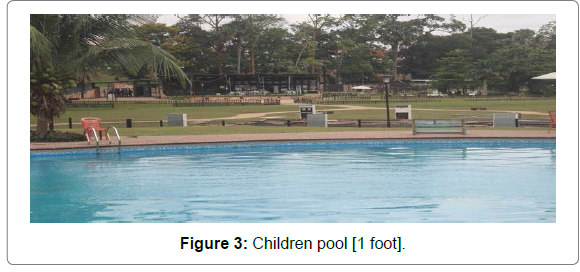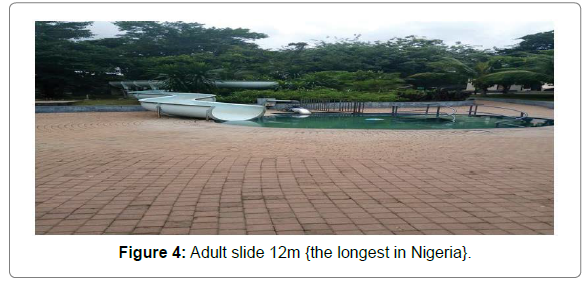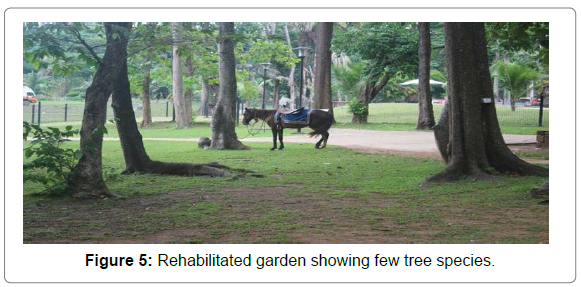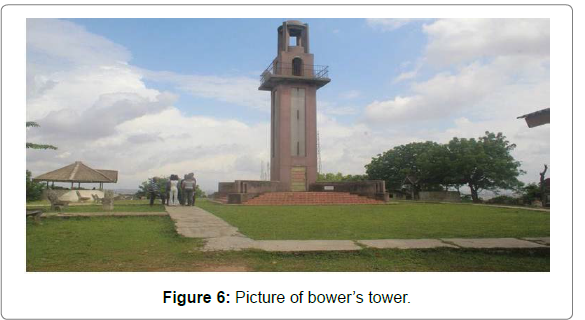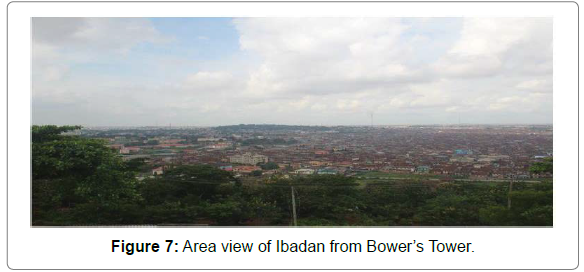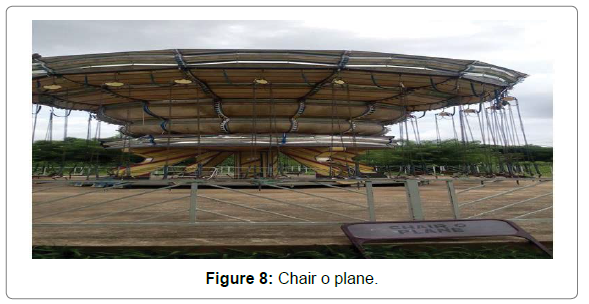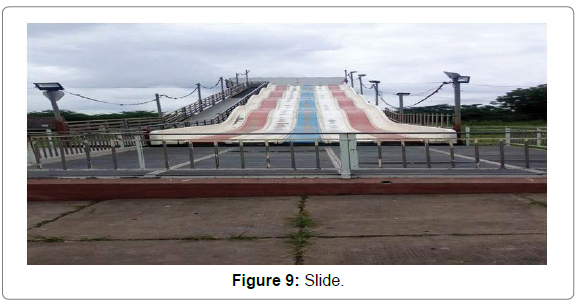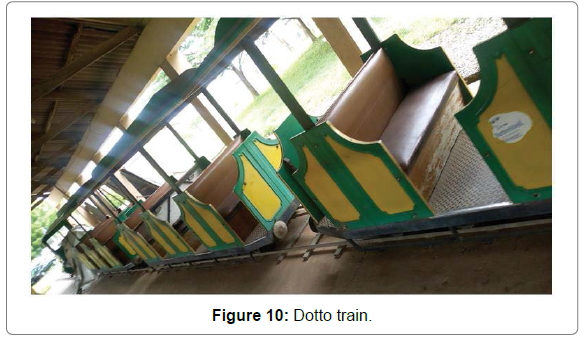Research Article, J Fashion Technol Textile Eng Vol: 9 Issue: 11
Analysis of Recreation Facilities in Ibadan Metropolis, Nigeria
Adewale Olufunlola Yoade*
Department of Urban and Regional Planning, Wesley University Ondo, Nigeria
- *Corresponding Author:
- Adewale Olufunlola Yoade
Department of Urban and Regional Planning, Wesley University Ondo, Nigeria
E-mail: yoadewale@ yahoo.com
Received Date: October 13, 2021; Accepted Date: November 23, 2021; Published Date: November 30, 2021
Citation: Yoade AO (2021) Analysis of Recreation Facilities in Ibadan Metropolis, Nigeria. J Fashion Technol Textile Eng 9:10. 227.
Copyright: © All articles published in Journal of Journal of Fashion Technology & Textile Engineering are the property of SciTechnol, and is protected by copyright laws. Copyright © 2020, SciTechnol, All Rights Reserved.
Abstract
Leisure and recreation have become important concerns in modern day societies. It is an essential part of human life and the role recreation plays in our societies has to do with health benefits, economic development, and prevention of crime. This paper examines analysis of recreation facilities in Ibadan, Nigeria. Data for analysis was obtained from staff and patronage of Agodi Garden, Bower’s Tower and Trans Amusement Park in Ibadan through a questionnaires survey. A total number of 221 structured questionnaires were randomly distributed out of which 203 were successfully retrieved and analyzed. The result revealed that over 66.3% of the tourists were visiting the destination for the very first time with a few of the respondents visiting for a second time. It was also observed that 32.5% of the respondents were visiting the study area for second time. This repeated visit might have been as a result of their satisfaction during their previous visit or because they did not visit all the attraction during the previous visit. Therefore, there is the need for the government to invest seriously in capital projects and create enabling environment to attract foreign investors for the sector to be able to provide the much needed infrastructure for economic development.
Keywords: Recreation; Facilities; Garden; Tower; Amusement
Introduction
Park and recreation services are an important function of government in all modern nations. Such services are found at the municipal, county, state and federal levels, as well as special park and recreation districts, which have taxing authority [1]. Recreation has become universal after the Second World War which has increase the mental capacity and prosperity of neighbourhood, communities and nation [2,3]. A surge in the recreational ability of people occurs in the late 20th century in developed countries than the third world [4]. The research carried out by NSRE in 2003 indicated that nearly all American partake in one form of recreation (97.6%), the research was carried out for adult from age 16bupward. The research also revealed that 207.9 million people in US engage in one form of recreation to another. The same research also indicated that time spent on recreational activities has also increased tremendously since 1990. The result also proved that university graduates who earn more than $50 million annually recreates more than people with low wages. Morgan [5] shows that large number of respondents to a survey conducted in Helsinki recreate within the last one year and do visit recreational centre at least once within two days [6].
Furthermore, this history of recreation goes far back in time, but recreation really took off when the Industrial Revolution hit Great Britain in the 1700s. The Industrial Revolution revolutionized work in the modern world, and helped create the modern factory environment. Machines mechanized the manufacture of fabric and fibers, and this ultimately led to more leisure time for the workers. They worked long hours in the factories, but they also had time off, and most employers gave at least some holidays off. Thus, people who had labored from dawn to dusk on farms in rural England, moved to the big city, got jobs in factories, and had leisure time away from their jobs. Recreation carries different meaning to different individuals and it is applied to great variety of activities. The word ‘Recreation’ stems from the Latin word “recreatio”, meaning that which refreshes or restores. Merriam Webster Dictionary therefore defines recreation as a means of refreshment of strength and spirit after work.The modern age is full of complexities, a man in order to survive has to do lot of physical and mental work, resulting in fatigue.
The concept of zoo started in the ancient times and the basis of such establishment primarily is to introduce wild animals to the urban population. A zoological garden is a facility in which animals are confined within enclosures, displayed to the public, and may also be bred. According to Omonona and Ayodele [7], zoological gardens are places where wild animals and sometimes strange domestic animals are kept and exhibited to the public, where they are studied, bred and protected. They are perhaps the oldest form of wildlife tourism; efforts to tame and keep wild animals in captivity are nearly as old as human society itself. The currently accepted role of the modern zoo is the conservation of biodiversity and its display for educational purposes to members of the public. The wide and varied objectives of modern zoo management are in agreement with broad national objectives of wildlife conservation in Nigeria, viz: preservation of natural heritage, conservation for tourism and recreation, and utilization for food [8].
Recreation is an activity of leisure, leisure being discretionary time. The “need to do something for recreation” is an essential element of human biology and psychology. Recreational activities are often done for enjoyment, amusement, or pleasure and are considered to be “fun”. Recreation also, of course, includes activities for all age groups (children, senior adults, etc.), as well as various special populations (physically handicapped, mentally retarded, etc.). Several researchers have proved that there is relationship between well-being and health status of people that engage in recreational activities for 30 minutes a day or twice or three thrice a week, is beneficial to the health of man [9,10]. Further research by Vistad [11], and Timothy and Boyd [12] indicated that there is correlation between green field, parks and human health. They are of opinion that public health is conducive where there is green area, Ideal Park and facilities to encourage recreation by man. However, inadequate recreational planning agencies / policy framework and the consistent pressure of urbanization which in effect, has led to the incessant distortion of open space and biodiversity resources that are often perpetuated by profiteers who often create a constant tendency to encroach into public open space that should serve the recreational need of the city populace. Several studies have been carried out on recreation within and outside Nigeria, but less emphasis has been placed on compares of these facilities within the same vicinities; hence, this study.
Literature Review
The term recreation is a subjective term as it implies different meaning to different people. It is activities that engage people attention for leisure and play. Recreation is multifaceted activities that involve exercises of physical, cognitive metal, emotional and social interaction [13]. These activities lead to enjoyment, relaxation and profession for some who use it as means of livelihood. It freshen human ability and create a better health conditions. Thus, this implies that recreation involve both active and passive engagement of human body and soul together. Recreation is both indoor and outdoor in nature. This include visitation to national parks and garden, lake of importance to history, rivers, forest and sporting activities. It also involves the playing for fun such as trekking, fishing, hunting, festivals, camping among other. The engagement in recreational activities helps to create balance in both health and physical weebeing of individual, household, community and nation as well [14].
Also, household relationship is enhanced by recreation as it brings about mutual understanding, maintenance of physical and mental health. Strengthening of relationship between households and among the community is entrenched by recreational activities, increase mental development, create conducive environment for business, integrate society and reduce crime in the community at large. For any individual or group of individuals to achieve maximum level of satisfaction and benefits, he has to participate extensively on recreational activities. There is apathy on the part of people in participating in recreational activities due to some hindrances. The hindrances are the issues that can affect the participation of individuals to partake in recreation [11, 15].
Voda et al [16] developed an hierarchical model which categorises the hindrances to recreation in developing countries like Nigeria into three broad types viz: intrapersonal, interpersonal and structural. The intrapersonal hindrances are related to psychological constraints such as personality, attitude, moods, self-skill, kin and non-kin attitude. Interpersonal constraints are lack of proper time management, finance, family problem and lack of friendship for recreation. Structural constraints are thus: availability of recreational area, facilities, and accessibility to these facilities and infrastructure. Walker and Virden [17] opined that the structural recreational hindrance can be classified into four types namely, natural environment, social environment, territorial environment and institutional environment. Finance, time, little knowledge about recreation, family problem, crowding and distance to recreational venue are some of the constraints that affect recreation [2-3,18].
Availability of recreational infrastructure and facilities, attitude, perception of gender, race, assault, first aid services and poverty has been identified as constraints to recreation as well. Lack of care and broken equipment are other factors affecting preferences and participation of people in recreational activities [5, 7]. Income level of people play a prominent role in access to recreation, tis determine the ole of individual in partaken in recreational activities than any other constraints [11]. There is significant correlation between level of income and recreational potentials among people. The high income level people have a higher potential to recreates more than the lowincome people [8]. Research carried out by Searle and Jackson [19] in Canada shows that high income earner recreate more than the poor. There is apathy on the level of participation in outdoor recreation between different genders in the developing world. Male are more involved in recreation than female [13,15].
Australia Bureau of Statistics indicated that there is high level of male participation in recreation than female among the same age group [20]. There are more domestic activities carried out by female than male which hinder the ability of female to partake in recreation. Another problem of female apathy to recreation has to do with assault and rape [21,22]. Finance is another constraint that affect female in partaken in recreation, as they depend on their hubby for their finances of their recreational activities. This is most common where women are seen as weaker vessels, so have limitations for recreation.
Recreation is a function of age and state of health of people as healthy people and youth are more involved in recreation than old people. Health issues and aging has been identified as a hindrance to recreation among the adults. Grahn and Stigsdotter indicated that with health issues are less interested in recreational activities. 28.8% of the adults in US between the ages of 65 and 74 have lower ability to recreate less frequently than their counterparts who are healthy. Age has an important effect on recreational potential because as people get older, their ability to recreate reduces due to chronic health problem (NSRE).
Jackson and Scott indicated that health problems, lack of companion, and fear of crime are the most significant recreational constraints for old people. Infrastructure and recreational facilities in recreational area also contributed to the ability to recreate. This can either encourage or discourage recreation, as lack of it will reduce the ability and where it is available, it encourages the ability to recreate. Bright and Neuvonen et al. revealed that people recreates more where there is an opportunity for them to do so. Availability of recreational facilities such as picnic table has ability to increase the recreational potentials two and half fold.
Recreational potentials availability is a function of age as different age group requires different recreational facilities to allow them to recreate well. The research by Irwin et al. and Gobster implies that availability of facilities affects the choice of recreation among the races, such as Hispanics choice of recreation and participation due to their preferences and age group. Stodolska and Livengood corroborated this assertion when comparing the recreational potentials of American Muslims which proved that lack of worship centre and gathering among women affects their ability to recreate in US. The total distance in terms of special distance and the financial distance is also a factor to ability to recreate.
Recreational area that are closer to neighbourhood encourages people to visit the place than a place that is farther, this is due to time and financial resources outlay it requires to get to the recreational site. This indicated that the farther the recreational site the lower the frequency of visitation and vice versa, therefore, recreational facilities has to be closer to urban centres. There is no universal standard about the distance of recreational site to neighbourhood, but a reasonable distance of not more than one kilometre is ideal for recreational at local level, while the distance of national and regional recreational facilities may be more depending on the choice of the user. Research in the Scandinavian countries indicates that for any daily recreation, the distance should not be more than between 250 and 300 meters, but the weekly activities such as live football match could be farther.
McCool’s has revealed that though recreational space constitutes an important component in urban development, recreation planning and management are very paramount to achieving any success. In essence open recreational planning has always been confronted with series of challenges which often emanate from fundamental shifts in social values and preferences, large scale demographic changes, development of new technologies, economic restructuring and new perspectives on public land governance and decision-making. This emphasis is germane to the study only in one aspect: that is, the continuous swing of emphasis by government and its agencies from recreation/open space development to other societal needs.
Research findings showed that since the beginning of western civilization, the real evidence of open public space development was found around many towns or cities in the form of squares, which were planned to be centrally located. Public squares were the first recognized public space elements in town and they were often anchored with the singular function of enhancing urban livability. At the same time, they provided good identity to the towns/cities centers development.
Demand and supply of recreational facilities: Demand and supply as used in recreational or environmental services have many interpretations across different disciplines, agencies or groups. Roberts, has defined demand in recreation as the number of persons (or units of participation) requiring to take part in a particular recreation activity. Current demands may manifest in different forms - as effective deferred and potential demands. All these can be hypothetically forecasted into the future recreational need of a place where potential demands (that is, those without the means or time to participate, but who could be converted) are possibly converted to effective demands provided their social/economic status change. Haas has brought the issue of future recreational demands to plain light having defined Recreation demand as the estimated number of people who are projected to participate in a particular recreation opportunity at some predetermined future and location.
The estimated number of people is typically expressed as number of individuals and groups (e.g. 10,000 visitors, 120 to 150 groups) the number of people can only be expressed as a percentage increase or decrease in participation from some baseline year. In developed countries across the globe, there has been wide spread of urban redevelopment which embraces obsolete uses of space in order to manifest what called a synthetic rural community lifestyle. This idea which has increased in tempo over the years upon attempts to achieve sustainable metropolitan growth is viewed as a malformation. Moreover, it is being noted by many researchers that supplying outdoor recreation is taking on an increasing sense of urgency as open and publicly accessible lands experience increased demand pressures.
As urban landscapes become fragmented by private residential and commercial developments, the extent and quality of accessible public recreation lands becomes increasingly scarce. Moreover, with a match-able growth in demand for opportunities to partake in outdoor recreation, there has been urgent demand to satisfy this and increasingly creative, management input for those charged with prioritizing scarce public resources. The importance of open recreational space depends not only on the ability to supply environmental services, but also on the demand for such services. An urban area with a large number of users of a particular open-space service will have a greater need or demand for the type of open space that supplies the required service. The first step to achieving any meaningful advancement in cities recreational plan and development is making the resources (facilities) available suitably at various locations with good accessibility.
According to Clawson and Knetsch and Zegras, certain factors were identified as to have great influence on particular recreation areas. Among others these include first, factors relating to the potential recreation users as individuals; second, factors relating to the recreation area itself; and third, relationships between potential users and the recreational area viz: the time required to travel from home to the area, and return; the comfort or discomfort of the travel; the monetary costs involved in a recreation visit to the area; and the extent to which demand has been stimulated by advertising.
The Location Theory: The behavior of individuals as well as firms and government agencies with regard to location are central to regional development. In one sense, the problem of backwardness will remain with a region as long as it suffers from government development policies. When an urban environment is neglected in terms of location of services or industries, certain factors are at work producing limitations to the growth. We find that such location will lack adequate interactions that can allow for the effectiveness of its ability to manipulate available resources to its advantage. This theory is all about location decisions of firms and government agencies as they tend to either minimize or maximize spatial differences and equalities. The theory is relevant to this research in the sense that it illuminates the policy of equitable distribution of open space resources (that is, the recreational sport and parks) and equitable accessibility by the users. In that case all recreational spots should be situated to every part of the city concerns. Equitable accessibility with less transportation cost is being held as one of the vital ingredients in open recreational space planning. The proximity factor has significant role in this type of land use plan. Travelling to recreate is not ideal as extra cost can nullify the actual intention. This probably explains reasons why most stadia especially in the developing cities are constantly underutilized after colossal amount of dollars have been expended on such stadia. For instance, Abuja National stadium (Nigeria) has experienced this ugly situation of wasting investment in recent time. Among others involving costs, transportation cost usually frighten potential recreation users away from achieving their recreational goal.
Study Area
Ibadan is the capital and most populous city of Oyo State, Nigeria. With a population of over 3 million, it is the third most populous city in Nigeria after Lagos and Kano; it is the country’s largest city by geographical area (Figure 1). At the time of Nigeria’s independence in 1960, Ibadan was the largest and most populous city in the country, and the second most populous in Africa behind Cairo. Ibadan is located in south-western Nigeria, 128 km inland northeast of Lagos and 530 km southwest of Abuja, the federal capital, and is a prominent transit point between the coastal region and the areas in the hinterland of the country. Ibadan had been the center of administration of the old Western Region since the days of the British colonial rule, and parts of the city’s ancient protective walls still stand to this day. The principal inhabitants of the city are the Yoruba’s, as well as various communities from other parts of the country.
Ibadan is located in south-western Nigeria in the southeastern part of Oyo State at about 119 kilometers (74 miles) northeast of Lagos and 120 kilometres (75 miles) east of the Nigerian international border with the Republic of Benin. The city ranges in elevation from 150 m in the valley area, to 275 m above sea level on the major northsouth ridge which crosses the central part of the city. The city covers a total area of 3,080 square kilometres (1,190 sq. mi), the largest in Nigeria. Ibadan, the city “scattered among seven hills”, is synonymous with Bower’s Tower. Standing atop the tower one could see at a glance the four corners of Ibadan metropolis. It gives a panoramic view of all the important places in the ancient city. One can see a bird’s eye view of City Gate, the University College Hospital (UCH), University of Ibadan, Adebayo, Cocoa House, Dugbe Market, Agodi Gardens, Trans Amusement Park, among others.
Agodi Garden: Agodi Gardens is a tourist attraction in the city of Ibadan and also called Agodi Botanical Gardens, The site is a serene environment on 150 acres of land. Formerly called Agodi Zoological and Botanical Gardens, Agodi Gardens was created in 1967. The garden was destroyed by the Ogunpa flood disaster in 1980 as most of the animals were swept away by the raging water. The garden was renovated in 2012 by the Oyo State Government and the new Agodi Gardens was reopened in 2014. Agodi garden is an ex-situ conservation site on a wetland and it occupies about 13 acres (approximately 5.3 hectares) of land. The geographical coordinates are Latitude 7024125.01”N and Longitude 3053157.35”E with an elevation of 191m above sea level. The tropical climate of Ibadan in which the garden is located provides a moderate and optimal weather for the Garden. Agodi Garden is positioned North-East of Oyo State Secretariat, South-West of the University Teaching Hospital, and North-West of the Premier Hotels (Personal Observation). Agodi Park and Gardens has lost most of the ecological functions it was known for. Heavy deforestation has really taken its toll on the site, adjacent forest and the surrounding communities. Also, many bird and animal species that were sighted on free range prior to the flooding of 1980 and the present rehabilitation are hardly or no longer found again. Though it will be difficult to fully restore the Gardens to its original and ecologically purpose-minded state, proper rehabilitation and reclamation procedures must be duly followed so as to balance economic gains with ecological benefits.
Activities that are meant to bring joy and involve fun and excitement are referred to as recreational activities. These activities are taken up during leisure time and are generally out door in nature. Taking part in sporting activities, working out at gym, hiking, climbing, sailing, fishing, hot air ballooning etc. are some recreational activities that people take up to kill boredom and fill their leisure with thrill and excitement. Thus, experiences and activities that an individual indulges during his leisure time for some enjoyment and pleasure are referred to as recreation. Recreation is an activity of body and mind which gives relief from tension and fatigue. When we continue doing a work or performing an activity regularly and continuously for some hours, it gives us physical and mental fatigue and strain (Figure 2-5).
Bower’s Tower: The colonial subjugation of Africa eroded the African people’s socio-political and economic structures while the emergence of the colonial project in itself created a new scenario, leaving bitter memories in the minds of the colonized. Despite this ugly episode, there were certain colonial officials who left memories in the hearts of the people among whom they administered. One of such was Captain Robert Lister Bower in 1893, he served as Resident and Travelling Commissioner for the interior of Yorubaland in south-western Nigeria from 1893-1897 and in his honor a tower was erected by the people of Ibadan under the supervision of Taffy Jones, the same engineer that designed Mapo Hall. The memorial tower symbolizes the home of Ibadan’s illustrious Generalissimos, the settlement of the great Ibadan warlords in the 17th century and a plethora of meaning. On the hand, it also perceived the people’s reflection of the footprints of Bower and in the annals of their history, it necessitated the erection of that historic monument as a memorial of his relatively peaceful era, socio-economic development as well as his general administrative acumen in the course of his service among them which remain indelible. As a rider to this, the monument serves as a reminder to the Ibadan people in particular and the Yoruba in general, of the man who firmly established the loyalty of their forebears to the British imperial crown.
According to one of the respondents, he said, “I have been living in Oke Are since my youth”, Bower’s Tower was erected in the 1930s by the Ibadan Native Authority but was unveiled by Captain Robert Lister Bower who was then the Resident and Travelling Commissioner for Ibadan and the Interior of Yoruba land in the South Western Nigeria. The hill was named after him. He added, “It was here (atop of the tower) Captain Robert Lister Bower was overseeing what was going on in the city and he administered his government from here and other Yoruba towns.” Omotayo Taiwo another resident and an old staff of the tower observed that the tower was named after Bower in appreciation of his contribution to the development and growth of Yorubaland, he was not the one that built it but he unveiled it in 1936 (Figure 6 and 7). Paradoxically, many perceive the tower as a monument of humiliation and diplomatic maneuvering. Despite the various sides of the pendulum, the vivid truth and his works cannot be erased from the sands of time.
Bower’s Tower on Oke–Are, as the home of Ibadan’s illustrious Generalissimos, symbolic monument of peace and tranquility, the settlement of the great Ibadan warlords in the 17th century and the common lingo of the ancient city. No wonder there is a saying that: “Whoever comes to Ibadan and has not visited this Tower (called Layipo) to view the city does not know Ibadan (Ibadan lo mo, o mo Layipo)”.
Trans Amusement Park: Trans Amusement park is a fun to be with loads and lots of activities to partake in. There is a lawn that is trimmed and taken care of regularly which has a sitting area where guests can relax and take in the ambien of the surrounding. There are lots of facilities here to make sure one have an unforgettable experience. This park is a place whereby families and friends comes together to have fun and nice picnics. Trans Amusement park is located at the South West Region of Nigeria: old airport Samanda Ibadan because the location was the former Ibadan airport but was moved to another location because of the residential land uses around it. Trans Amusement park was founded on December 23rd 1989 and was commissioned by Mariam Babangida. Their time of operation is both during the weekdays and also on weekends but the opening and closing times varies, during the week days they operate from (9am to 5pm) while on weekends they operates from (10an to 6pm).
In order to gain your entrance into the park the sum of #200 will be paid at the entrance to the people in charge and this particular sum is excluded from the other tokens that will be paid when any of their facilities are to be used. This is because the funds generated from the park is what that is been used for the payment of all their staffs salaries likewise the day to day running of the activities as the government has been less concerned about the funding. The park does not have a specific time of patronage just that people patronize them more during festive periods (Figure 8-10).
Data and Methodology
The study utilized both primary and secondary data. Primary data was sourced using personal observation, oral interview and structured questionnaires. According to Simon [68](2015), there are 32 open space/recreational facilities in Ibadan metropolis. However, 3 out of 32 facilities were randomly selected for this study. Questionnaires were administered randomly on the tourists on weekends for two months (December and January). Purposeful sampling was used to pick the selected months (December and January) because those recreational facilities usually have high number of patronage during this period. Therefore, a total number of 221 questionnaires were administered out of which 203 retrieved, accounting for 91.9% response rate. Interviews were also conducted on the members of staff of the selected recreational facilities. The respondents were asked to score the factors affecting the performance of the recreational facilities based on the scale of 1-5 in which 5 indicates extreme importance and 1 indicating least importance. Simple descriptive statistics and importance indices were used to analyze the data. Secondary data was sourced from literatures on recreation, leisure and tourism.
Findings and Discussion
Socio-Demographic Characteristics of Respondents: The sociodemographic characteristics of the surveyed tourists as shown in table 1. Findings showed that majority of the tourists visiting the study area are males with 55.7% while females are 44.3 of the respondents in the study area. This depicts that males have passion for tourism than their female counterpart. The findings of the demographic characteristics of the respondents’ show that a higher percentage (45.8%0 of the tourists are between the ages of 20 and 40 years, with the older people less represented. This is quite similar to the finding of Ogunbodede, who observed that majority of the tourists to Idanre hills were within the ages of 21 and 40. He explained that these age groups constitute the economically viable set of people who can afford to spend money on tourism, and those that are physically strong to climb the great steps.
| Frequency | Percentages of Respondent’s | |
|---|---|---|
| Gender | ||
| Male | 113 | 55.7 |
| Female | 90 | 44.3 |
| Age | ||
| < 20 | 68 | 33.5 |
| 21 – 40 | 93 | 45.8 |
| 41 – 60 | 39 | 19.2 |
| > 60 | 3 | 1.5 |
| Others | 1 | 0.5 |
| Academic Qualification | ||
| Primary | 12 | 5.9 |
| Secondary | 45 | 22.2 |
| Tertiary | 143 | 70.4 |
| Others | 3 | 1.5 |
| Occupation | ||
| Students | 101 | 49.8 |
| Artisans | 12 | 5.9 |
| Business men | 23 | 11.3 |
| Civil servant | 66 | 32.5 |
| Total | 203 | 100.0 |
Table 1: Socio-Demographic Characteristics of the Respondents.
It was also discovered that almost all the respondents are educated with 70.4% of them having tertiary education, suggesting that majority of the tourists to this site are aware of and understand the importance of tourism. Findings established that49.8% are civil servants, 32.5% of the tourists are civil servants while 0.5% of the tourists falls under other categories. It can therefore be stated that tourist visiting the study area are majorly civil servants. This indicates that’s tourists vising the study area are youths and they come for excursion form their various institutions.
Frequency of Visits and Purpose of Respondents’ Visit: The result revealed that over 66.3% of the tourists were visiting the destination for the very first time with a few of the respondents visiting for a second time (Table 2). It was also observed that 32.5% of the respondents were visiting the study area for second time. This repeated visit might have been as a result of their satisfaction during their previous visit or because they did not visit all the attraction during the previous visit. It has been noted that tourist satisfaction influences their decision to return, while some argued that the perceived attraction of a destination could influence their visitations again. It was discovered from the study that the main purpose of visit was for recreation while some of the tourists visited the site for educational, research, cultural festivals purposes among others. Finding established that majority (61.6%) tourist visit for recreation while education and research purposes accounted for 19.2% and 12.3% respectively. Also, the overall satisfaction level of the respondents reveal that majority of them (59.6%) were generally satisfied with their experience in the study area. Their satisfaction might be because they perceived that their experience at the facility met their expectation and perceived values of the site which is more than the money paid. It has been proven that tourists’ satisfaction is directly influenced by their perception. The high percentage of respondents willing to revisit (90.8%) might be as a result of their satisfaction with their experience or because they were unable to visit all the attractions during this visit. Some researchers are of the opinion that satisfied tourists tend to repeat their visit and transmit their positive experience to others. Tourist satisfaction influences their choice of destination and the decision to return, which is one contributing factor to destination loyalty intention. Therefore, enhancing tourists’ satisfaction is a prerequisite for the development of strategy leading to a destination’s enhanced attractiveness and its competitive positioning.
| Elements | Frequency | Percentage (%) |
|---|---|---|
| Frequency of visit | ||
| First visit | 135 | 66.5 |
| Second visit | 66 | 32.5 |
| More than twice | 2 | 1.0 |
| Purpose of visit | ||
| Education | 39 | 19.2 |
| Relaxation/leisure | 125 | 61.6 |
| Research | 25 | 12.3 |
| Festive season | 14 | 6.9 |
| Level of satisfaction | ||
| Very satisfied | 121 | 59.6 |
| Satisfied | 69 | 34.0 |
| Not satisfied | 13 | 6.4 |
| Willingness to revisit | ||
| Yes | 183 | 90.8 |
| No | 20 | 9.2 |
| Total | 203 | 100% |
Table 2: Socio-Economic Characteristics of the Respondents.
From the results tourist ranked the following factors (poor planning, inadequate space, high cost of maintenance, among others) as the factors the challenges and problem facing their facilities in the study area. The tourists ranked lank of political will and high cost of maintenance as the first and least challenging factors with RMI of 0.824 and 0.512 respectively in Agodi garden. In Bower’s Tower, tourists ranked lank of poor planning and insufficient fund as the first and least challenging factors with RII of 0.819 and 0.543 respectively. Lastly, tourists ranked high cost of maintenance and inadequate space as the first and least challenging factors with RMI of 0.795 and 0.507 respectively in Trans Amusement Park (Table 3).
| Factor | Agodi garden | Bower’s Tower | Trans amusement | |||
|---|---|---|---|---|---|---|
| RMI | Rank | RMI | Rank | RMI | Rank | |
| Poor planning | 0.612 | 7 | 0.819 | 1 | 0.678 | 4 |
| Inadequate space | 0.784 | 2 | 0.774 | 2 | 0.507 | 8 |
| Security lapse | 0.691 | 4 | 0.728 | 3 | 0.601 | 6 |
| Insufficient fund | 0.687 | 5 | 0.543 | 8 | 0.552 | 7 |
| Shortage of manpower | 0.603 | 8 | 0.594 | 7 | 0.788 | 2 |
| Lack of political will | 0.824 | 1 | 0.621 | 6 | 0.753 | 3 |
| Credibility of park manager | 0.752 | 3 | 0.653 | 4 | 0.623 | 5 |
| High cost of maintenance | 0.512 | 8 | 0.636 | 5 | 0.795 | 1 |
Table 3: Recreation Management Index.
The tourist satisfaction index is presented in Table 4. Considering the overall ranking of the satisfaction of facilities in the study area, adequate planning was ranked first with TSI of 0.882. This was also identified by Olugbamila, WTO, and Yusuff and Akinde as an important factor in any recreation and tourist location. Funding was ranked lowest with TSI of 0.6168 respectively. The significance of private sector participation was also recognized by Walker and Shafer and Timothy and Boyd.
| Factor | Weighing | TSI | Rank | ||||
|---|---|---|---|---|---|---|---|
| 5 | 4 | 3 | 2 | 1 | |||
| Well planned | 123 | 57 | 11 | 9 | 3 | 0.882 | 1 |
| Well managed | 101 | 49 | 30 | 10 | 13 | 0.814 | 2 |
| Wide ranging recreational services | 93 | 57 | 26 | 24 | 3 | 0.803 | 3 |
| Well hygienic | 86 | 48 | 16 | 42 | 11 | 0.754 | 4 |
| Well secured | 81 | 39 | 41 | 33 | 9 | 0.749 | 5 |
| Large space capacity | 72 | 51 | 27 | 48 | 5 | 0.738 | 6 |
| Ideally located | 63 | 52 | 42 | 14 | 27 | 0.694 | 7 |
| Funding | 31 | 43 | 42 | 84 | 3 | 0.616 | 8 |
Table 4: Tourist Satisfaction Index.
Conclusion and Recommendations
This study examined recreational facilities in Ibadan, Nigeria.
Based on the research findings, it is concluded that recreation is a valuable contributor to community sustainability and therefore, the government should ensure adequate funding and proper management in line with recreation development.
In view of the aforementioned challenges, the objectives of rehabilitating the Agodi Gardens have to be strictly adhered to. More attention has been paid to the Lake Park, boat house, garden or recreational section which has attracted so many visitors because of the recreational facilities and activities there. The zoo section needs a total rehabilitation and /or upgrade in terms of environmental management and stocking of animal species in proper housing system. This will improve the welfare of the animals and further attract more visitors to the site and consequently, generate more revenue for the government. For Bower’s Tower, there is need for government to provide the necessary funding towards the resuscitation of the monument and its immediate environment, after which it is expected to be contracted out to private individuals and corporate bodies to manage. Besides that, a binocular to be installed by the balcony on top of the tower to enable tourists have a clearer panoramic view of Ibadan. With all these facilities being put in place, it will become an international center of tourist attraction which its founding architects envisaged. Also, more facilities area needed in Trans Amusement that can also attract adults because most facilities they have are majorly for kids.
Government should properly fund the garden and equip the zoo to a modern standard. The health of the ecosystem should be of utmost priority considering the services it provides. Therefore, the government should discourage logging of forest trees and encourage reforestation of the park section with no commercial trees. Also, Government should build river channels to stop flood from getting into the garden and also create awareness for people to stop dumping dirty when there is rain downpour.
References
- Zarnoch S J, Bowker J M, Cordell H K (2011). A mixed-modes approach for estimating hiking on trails through diverse forest landscapes: the case of the Appalachian Trail. Can J For Res 41: 2346-2358.
- Carter T S (2005) Wildlife Tourism: impacts, management, and planning. Wildl Soc Bull 33: 1188-1188.
- Higginbottom K (2004) Wildlife tourism: An introduction. Wildlife tourism: Impacts, management and planning: 1-14.
- Zhang J T, Xiang C, Li M (2012) Effects of tourism and topography on vegetation diversity in the subalpine meadows of the Dongling Mountains of Beijing, China. Environ Manage 49: 403-411.
- Clark D L, Whitman R R, Morgan K A, Mackey S D (1980) Stratigraphy and glacial-marine sediments of the Amerasian Basin, central Arctic Ocean. Geol Soc Am: 181.
- Travis A S (2011) Introduction to UK upland planning for countryside conservation, recreation and tourism. Planning for tourism, leisure and sustainability: international case studies: 122-128.
- Omonona A O, Adetuga A T, Ajayi O O (2018) Nigerian Journal of Wildlife Management.
- Ayodele I A, Alarape A A (1998) Assessment of recreational potentials of Agodi gardens, Ibadan, Nigeria. J Trop For Res 14: 137-151.
- Popoola A, Tawose O, Abatan S, Adeleye B, and Jiyah F, et al. (2015) Housing Conditions and Health of Residents in Ibadan North Local Government Area, Ibadan, Oyo State, Nigeria. J Environ Sci Res Manag 7: 59-80.
- Carter T F (1896) A narrative of the Boer War: its causes and results. J Macqueen.
- Vistad O I (2003) Experience and management of recreational impact on the ground–a study among visitors and managers. J Nat Conserv 11: 363-369.
- Timothy DJ, Boyd SW (2015) Tourism and trails: Cultural, ecological and management issues. Channel View Publications: 64.
- Aramide K A, Odunlade R O, Balogun Z O (2018) Information needs and library services delivery for students with visual impairment in Oyo State, Nigeria.
- Wiedmann B P, Bleich V C (2014) Demographic responses of bighorn sheep to recreational activities: a trial of a trail. Wildl Soc Bull 38: 773-782.
- White D D, Waskey M T, Brodehl G P, & Foti P E (2006). A comparative study of impacts to mountain bike trails in five common ecological regions of the Southwestern US. J Park Recreat Admi: 24.
- Voda M, Moldovan L, Torpan A, Henning A (2014) Using GIS for mountain wild routes assessment in order to qualify them for tourism valorisation. Geogr Tech 9: 101-108.
- Walker J R, Shafer C S (2011) Mode of Experience on a Recreational Trail: An Examination of How Hikers and Mountain Bikers Focus Their Attention. J Park Recreat Admi 29: 21-38.
- Wood K T (2006) Assessing recreation impacts to cliffs in Shenandoah National Park: Integrating visitor observation with trail and recreation site measurements. J Park Recreat Admi 24: 86-110
- Zhong L, Buckley R C, Wardle C, Wang L (2015) Environmental and visitor management in a thousand protected areas in China. Biol Conserv 181: 219-225.
- Zhong L, Buckley R C, Wardle C, Wang L (2015) Environmental and visitor management in a thousand protected areas in China. Biol Conserv 181: 219-225.
- Olubode S O, Taiwo D M, Woghiren A I (2021) Floristic Structure of Some Selected Plots in Olokemeji Forest Reserve, Ogun State, Nigeria. FUTY J Env 15: 65-72.
- Durojaiye B O, Ikpi A E (1988) The monetary value of recreational facilities in a developing economy: a case study of three centers in Nigeria. Nat Resour J: 315-328.
 Spanish
Spanish  Chinese
Chinese  Russian
Russian  German
German  French
French  Japanese
Japanese  Portuguese
Portuguese  Hindi
Hindi 